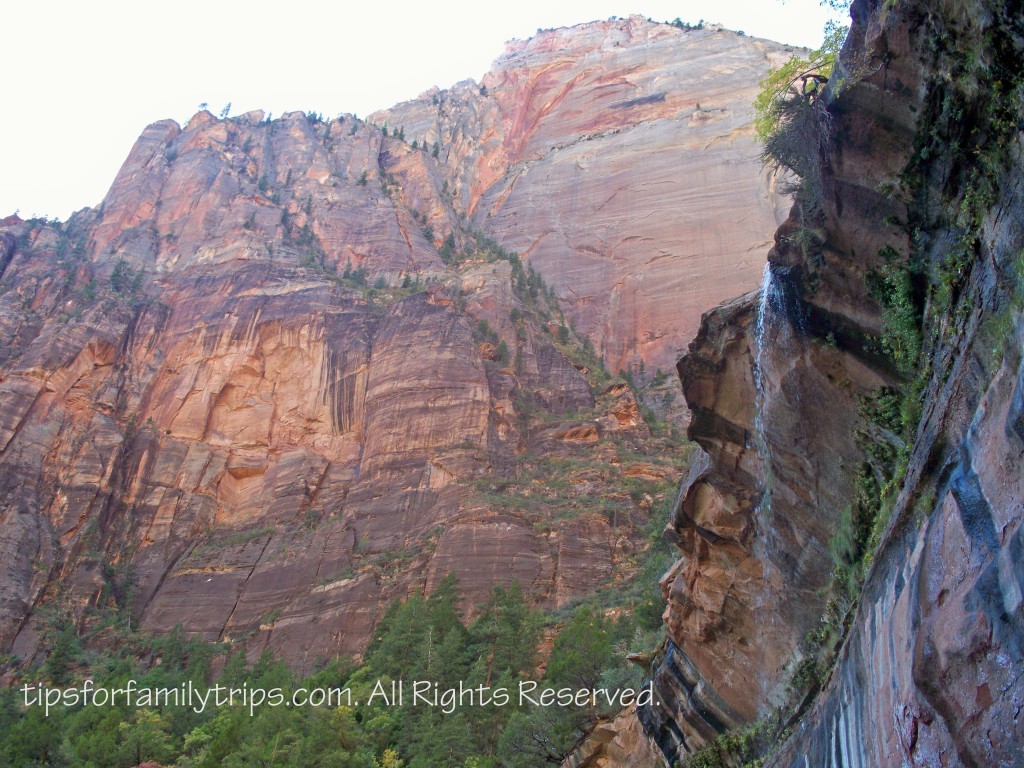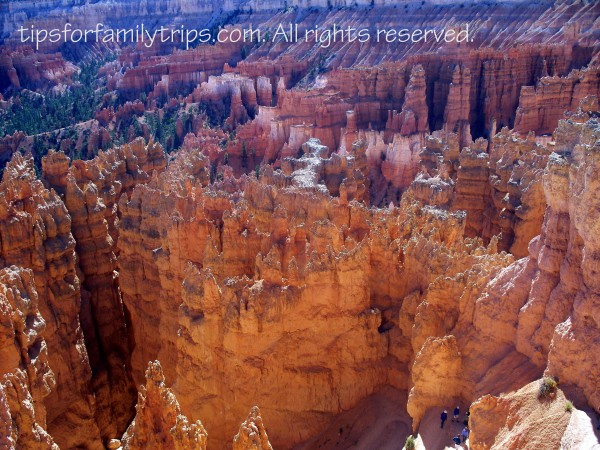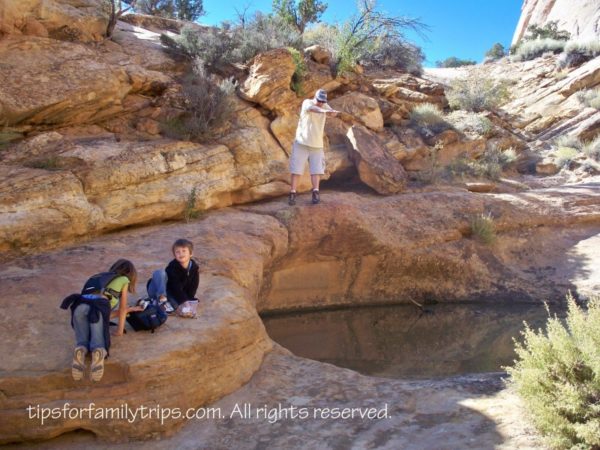Would you believe that in July, in the center of Yosemite National Park, we enjoyed an entire day where we never saw another soul? It’s possible, provided you depart from the usual tourist destinations in the valley and explore Yosemite backcountry.

Backpacking Yosemite National Park with kids:
We chose to hike a portion of The John Muir Trail, a 211 mile path between Happy Isles in Yosemite Valley and Mt. Whitney in the California desert. While hardcore backpackers will hike the entire length in as little as 15 days, the Yosemite National Park portion of the John Muir Trail makes for a nice escape for backpackers with less time (or young kids). Backpackers hiking the John Muir trail in Yosemite traditionally start at the base of Vernal Fall in Yosemite National Park, and climb upward past Vernal and Nevada falls, Half Dome, and Little Yosemite Valley campground while making their way toward Tuolumne Meadows. For our John Muir Tail trip with young kids, we decided to tackle the John Muir Trail in reverse, which allowed for more downhill sections of trail and fewer crowds until the end of our journey.
Planning a Yosemite backcountry trip:
Backpacking the Yosemite National park backcountry with kids involves planning. Anyone planning to hike any portion of the John Muir Trail must obtain a Yosemite wilderness permit. Permits can be secured up to 168 days prior to the date desired, and for summer backpacking in Yosemite, reserving a permit the full 168 days out is recommended.
Upon arrival to Yosemite, you’ll need to check in at a Yosemite National Park Wilderness Center, where you’ll pick up your permit as well as bear canisters if you don’t have your own. Bear canisters must be used to store all food and scented items such as toothpaste, medications, and lotion, and can be rented (for only the price of a deposit). You’ll need to leave space in your packs for these.
If you plan to hike Half Dome, Half Dome permits are required, and they are separate from backcountry permits (though you can obtain both simultaneously). And if you plan to stay a night before or after your backpacking trek in Yosemite National Park (recommended), be sure to secure lodging early, as this is one of the most crowded national parks in America. Backpackers can also make use of free backpacker campgrounds the day before and after their backpacking trip.

On the John Muir Trail:
Day 1: Tuolumne Meadows to Sunrise Lake (3 miles)
In order to start our Yosemite backpacking trip in Tuolumne Meadows, we began at the Sunrise Trail Head at Tenaya Lake on Tioga Road. We followed the Sunrise Trail up steep switchbacks to connect with the Forsyth Trail near beautiful Sunrise Lake (a great first night camping option).
Day 2: Forsyth Trail to Clouds Rest and beyond (8 miles)
From Sunrise Lake, we continued to follow the Forsyth Trail to intersect with the Clouds Rest junction, leading 2 miles to arguably the best viewpoint in Yosemite National Park. From Clouds Rest, hikers can see the entire Yosemite Valley, including an unique view of Half Dome. Note: the pinnacle of Clouds Rest is fully exposed, with steep drop offs on each side. This is not a place for young children or anyone with vertigo or a fear of heights. Since I fall into that category (hiking with a small child), we viewed the Yosemite landscape from just .2 mile below the top, which also offers wonderful vistas.
Hikers can continue past Clouds Rest to intersect with the John Muir Trail several miles later, but as this section of trail is still exposed and at great heights, we opted to return the 2 miles back to the Forsyth Trail and join the John Muir Trail much earlier. This first section of John Muir winds through old growth forest alongside Sunrise Creek, and affords several nice camp sites adjacent to this water source. This section of the John Muir Trail is less traveled, but we were still surprised to find we didn’t encounter a single hiker all evening, night, or morning.

Day 3: Sunrise Creek to Little Yosemite Valley (5 miles)
Day 3 took us along the John Muir Trail from Sunrise Creek into Little Yosemite Valley. This backpackers’ haven offers numerous campsites along the Merced River (perfect for swimming in after a long day hiking!). Though lively, Little Yosemite is a fun oasis for hikers, offering conversation and companionship around the communal fire pit after days of relative isolation.
En route to Little Yosemite Valley, the John Muir Trail offers views of Half Dome, and the steady accent of hikers navigating its cable system to the top. Should you wish to ascend Half Dome yourself, the trail intersects with the final 2 miles of the Half Dome Trail mid-way through your hike down to Little Yosemite. Note: this is another steep, exposed trail. Though children can ascend it, be advised that very small kids may not be able to reach the cables, essential to a safe ascent. Our 13 and 11-year-olds could make the trek, but not our seven-year-old. For those not challenging Half Dome, it’s fun stop on John Muir Trail or Little Yosemite Valley and use binoculars to watch the climbers.
Day 4: Little Yosemite to Valley Floor (4.5 miles)
Our final day on the John Muir Trail led us down from Little Yosemite Valley to spectacular Nevada Fall, where the trail splits into the John Muir or the popular Mist Trail. We opted for the Mist Trail in order to glimpse the best views of nearby Vernal Fall, but the steps descending both falls are steep and can be slippery when wet. Be advised that the Mist Trail gets crowded with day hikers, and can be hard to navigate with overnight backpacks. The option of continuing on the John Muir Trail has its own set of disadvantages: it’s a longer route to the valley floor, and more exposed, providing little shade.
Safety on the John Muir Trail and in the Yosemite backcountry:
In addition to dizzying heights, bears, and crowds near the valley floor, backpackers need to be aware of the significant elevation gains to be experienced on the Yosemite section of the John Muir Trail. Elevations reach over 9,000 feet, necessitating plenty of water intake to prevent headaches and nausea. Other wildlife can pose a threat if hikers are not alert, including rattlesnakes — we encountered the biggest we’ve ever seen at Little Yosemite Valley.
Getting to and from Your Car:
Whether you hike the John Muir Trail from the valley floor up or from Tuolumne Meadows down, as we did, you’ll need transportation back to your car at the end of your trip. Yosemite National Park offers free shuttle service throughout the valley, but to travel to Tuolumne or vice versa, you’ll need to take Yarts, a paid shuttle service with stops in Yosemite Village and points throughout Tuolumne. Hikers cannot make reservations in advance for Yarts, and though we were told busses never fill up, that was not the case. Be sure to be at the stop before the allotted time and have cash in hand. One-way tickets were $8 at the time of our visit.











































